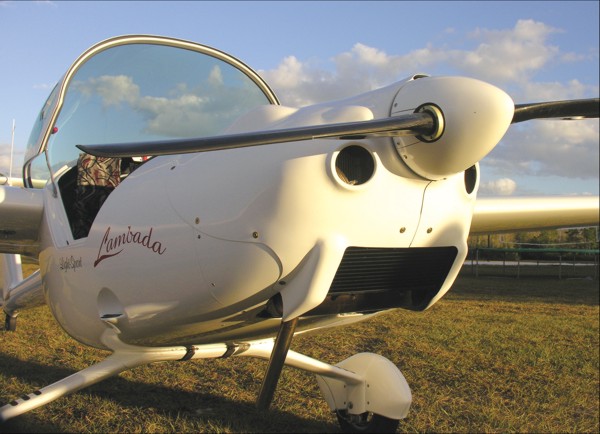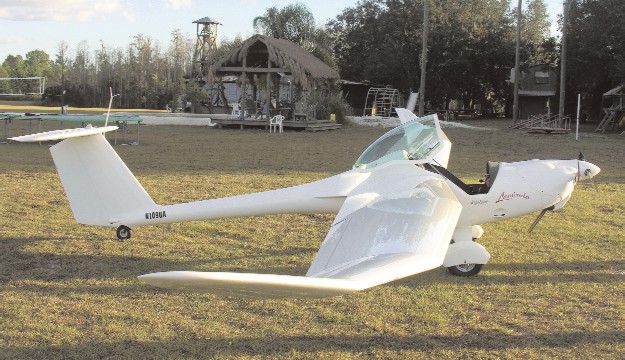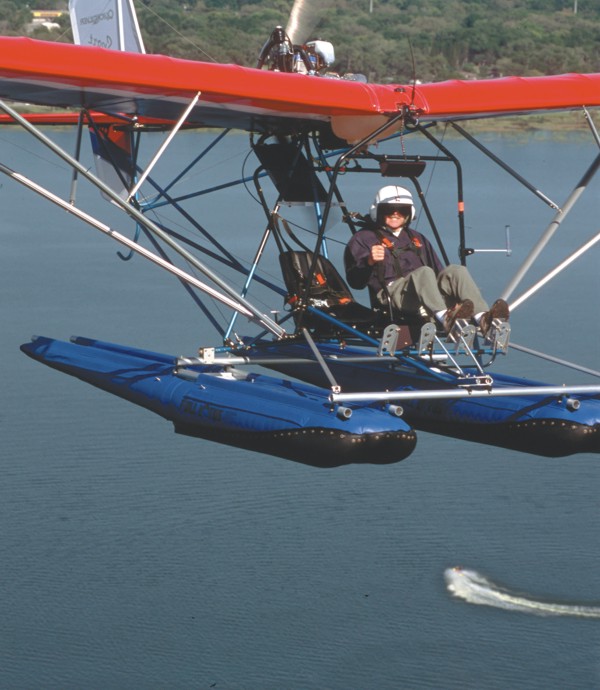
“It’s still the best,” is a phrase I could use referring to Quicksilver’s most-popular-of-all ultralights in general, the Sport 2S. Indeed it remains a delightful aircraft and the strutted construction appeals to many pilots. Or, I could be referring to flying an ultralight on floats, that being one of the very best ways to enjoy an ultralight. Or, I could be talking about both. You’ll want to read on and see. I might also be talking about the strutted version of the venerable Quicksilver model being the best of the design series. Or, I might be talking about the innovative company representing the Quicksilver 2S on floats in central Florida. Every one of these statements is accurate in one way or another. It was my pleasure to fly the Sport 2S on Full Lotus floats and it surely was a dandy experience. Is it the best? Well, it might be for you.


 "It's still the best," is a phrase I could use referring to Quicksilver's most-popular-of-all ultralights in general, the Sport 2S. Indeed it remains a delightful aircraft and the strutted construction appeals to many pilots. Or, I could be referring to flying an ultralight on floats, that being one of the very best ways to enjoy an ultralight. Or, I could be talking about both. You'll want to read on and see.
I might also be talking about the strutted version of the venerable Quicksilver model being the best of the design series. Or, I might be talking about the innovative company representing the Quicksilver 2S on floats in central Florida. Every one of these statements is accurate in one way or another.
It was my pleasure to fly the Sport 2S on Full Lotus floats and it surely was a dandy experience. Is it the best? Well, it might be for you.
"It's still the best," is a phrase I could use referring to Quicksilver's most-popular-of-all ultralights in general, the Sport 2S. Indeed it remains a delightful aircraft and the strutted construction appeals to many pilots. Or, I could be referring to flying an ultralight on floats, that being one of the very best ways to enjoy an ultralight. Or, I could be talking about both. You'll want to read on and see.
I might also be talking about the strutted version of the venerable Quicksilver model being the best of the design series. Or, I might be talking about the innovative company representing the Quicksilver 2S on floats in central Florida. Every one of these statements is accurate in one way or another.
It was my pleasure to fly the Sport 2S on Full Lotus floats and it surely was a dandy experience. Is it the best? Well, it might be for you.
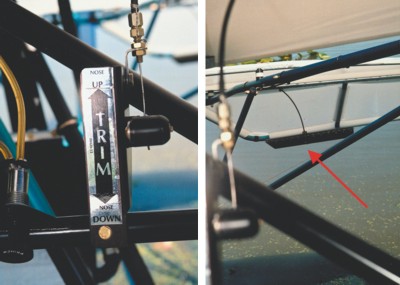

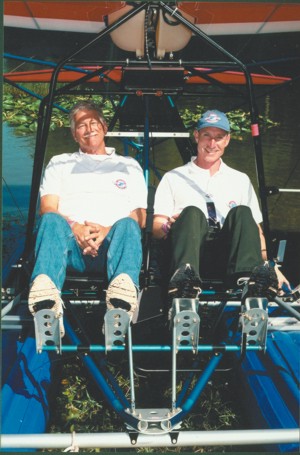
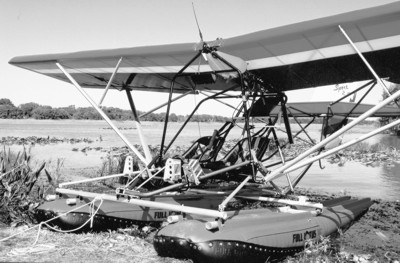
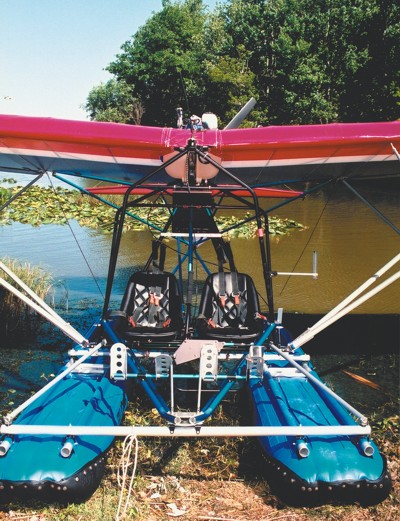
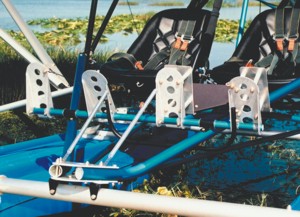
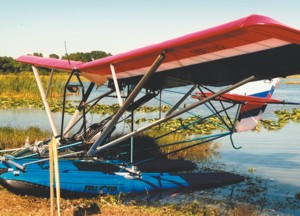

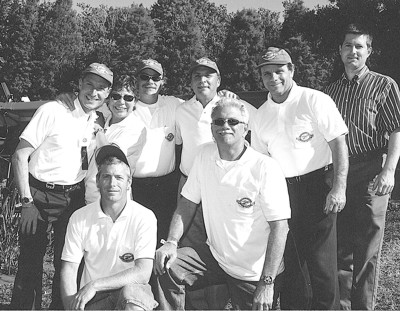

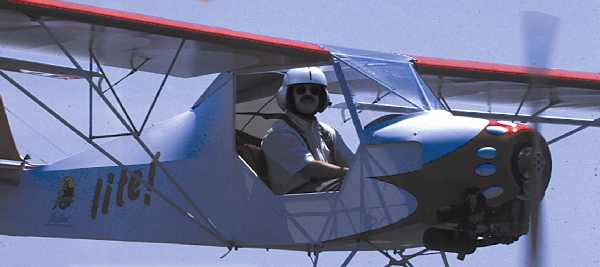 [UPDATE -- fall 2009: This article about the Kitfox Lite refers to a company now several years out of business. The new Kitfox producer sold the Kitfox Lite design to Kansas entrepreneur, James Wiebe. His company, Belite Aircraft, now produces the Belite Carbon 254 (and other variations) and has significantly changed structure with carbon fiber components to lighten the weight, assuring that it meets Part 103. For the latest info on their offerings,
[UPDATE -- fall 2009: This article about the Kitfox Lite refers to a company now several years out of business. The new Kitfox producer sold the Kitfox Lite design to Kansas entrepreneur, James Wiebe. His company, Belite Aircraft, now produces the Belite Carbon 254 (and other variations) and has significantly changed structure with carbon fiber components to lighten the weight, assuring that it meets Part 103. For the latest info on their offerings, 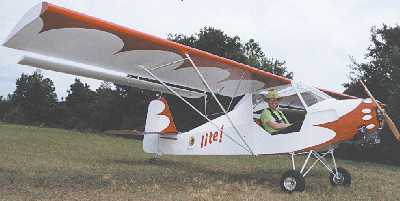





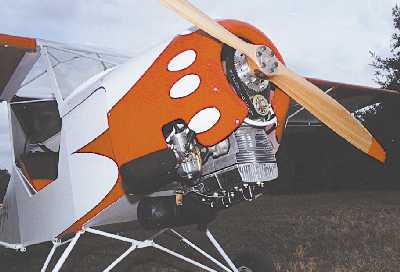




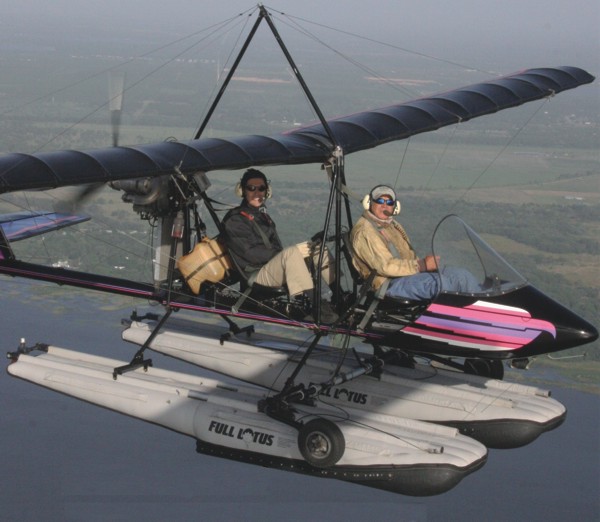 Things can change and yet stay the same. You can comprehend this paradox by considering the tandem 2-seat Drifter. Drifter production is under new management by someone many regard as a "rightful owner." Yet the basic flying qualities of the Drifter design are basically unchanged.
As 2007 started, Phil Lockwood again has all rights to the Drifter as part of a design, tooling, and inventory deal that rescued the Drifter and 2-seat twin-engine Air Cam from an uncertain future with investor Antonio Leza, who ran the operation for a few years.
Lockwood is associated with the Drifter due to his many years of work with the design. He once worked for Maxair proprietor Denny Franklin who pioneered this enduring shape. In the rough and tumble days of early ultralights, Franklin lost control of Drifter ownership and for a time the design wandered. More correctly, the new owners failed to take the Drifter forward and instead merely exploited its popularity.
Fortunately the airplane persevered. The Drifter ended up in production by Leza, or Leza-Lockwood as the Sebring company was first known.
Things can change and yet stay the same. You can comprehend this paradox by considering the tandem 2-seat Drifter. Drifter production is under new management by someone many regard as a "rightful owner." Yet the basic flying qualities of the Drifter design are basically unchanged.
As 2007 started, Phil Lockwood again has all rights to the Drifter as part of a design, tooling, and inventory deal that rescued the Drifter and 2-seat twin-engine Air Cam from an uncertain future with investor Antonio Leza, who ran the operation for a few years.
Lockwood is associated with the Drifter due to his many years of work with the design. He once worked for Maxair proprietor Denny Franklin who pioneered this enduring shape. In the rough and tumble days of early ultralights, Franklin lost control of Drifter ownership and for a time the design wandered. More correctly, the new owners failed to take the Drifter forward and instead merely exploited its popularity.
Fortunately the airplane persevered. The Drifter ended up in production by Leza, or Leza-Lockwood as the Sebring company was first known.
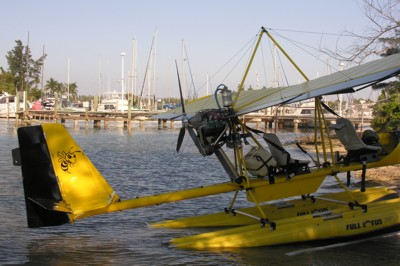

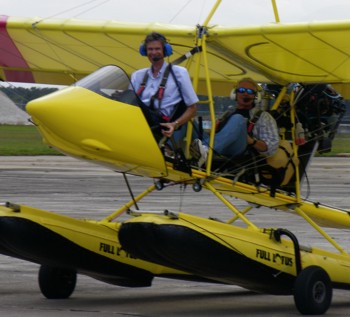



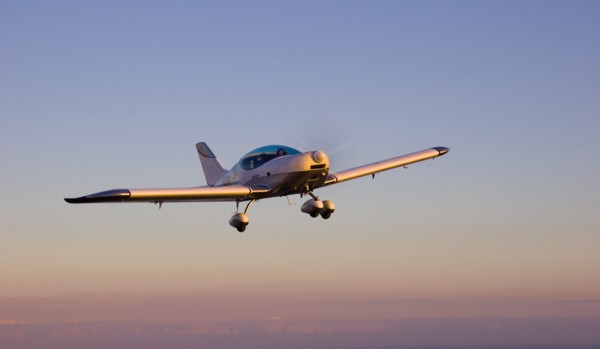

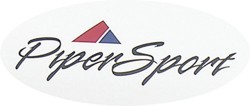 Full Line Producer
The contrast may be interesting to many, what with Piper offering a wide range of general aviation airplanes from the PiperJet to the PiperSport. To better put this in perspective, check this chart:
Valued in knots per purchase price dollars, the PiperSport comes in at $1,000 per knot, where the top of the line PiperJet is $6,111 per knot and the Meridian is $7,775 per knot. In other comparisons - such as range for dollar or payload for dollar -
PiperSport remains the value leader. This is hardly surprising as the PiperSport is way less than half the cost of the nearest model, and it helps Piper to offer a very broad line of aircraft to suit buyers of all types.
Especially notable in fuel burn comparisons, the PiperSport smokes all the other models by a wide margin, and that's before considering the cost advantage of using mogas when available, or the fuel and noise impact of flying Light-Sport Aircraft
compared to any other. It's no stretch to say that in our modern, environmentally sensitive age,
Piper needed LSA
Into this tasty brew let's add the solid brand of 72-year-old Piper Aircraft and what that means to potential buyers of a Light-Sport Aircraft. With 27 Piper dealers and 65 service centers, the company offers a network exceeded only by Cessna Aircraft (though several top LSA producers are closing on those numbers).
Full Line Producer
The contrast may be interesting to many, what with Piper offering a wide range of general aviation airplanes from the PiperJet to the PiperSport. To better put this in perspective, check this chart:
Valued in knots per purchase price dollars, the PiperSport comes in at $1,000 per knot, where the top of the line PiperJet is $6,111 per knot and the Meridian is $7,775 per knot. In other comparisons - such as range for dollar or payload for dollar -
PiperSport remains the value leader. This is hardly surprising as the PiperSport is way less than half the cost of the nearest model, and it helps Piper to offer a very broad line of aircraft to suit buyers of all types.
Especially notable in fuel burn comparisons, the PiperSport smokes all the other models by a wide margin, and that's before considering the cost advantage of using mogas when available, or the fuel and noise impact of flying Light-Sport Aircraft
compared to any other. It's no stretch to say that in our modern, environmentally sensitive age,
Piper needed LSA
Into this tasty brew let's add the solid brand of 72-year-old Piper Aircraft and what that means to potential buyers of a Light-Sport Aircraft. With 27 Piper dealers and 65 service centers, the company offers a network exceeded only by Cessna Aircraft (though several top LSA producers are closing on those numbers).
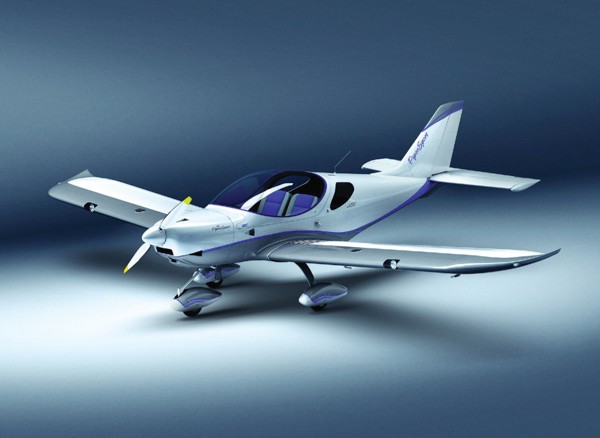









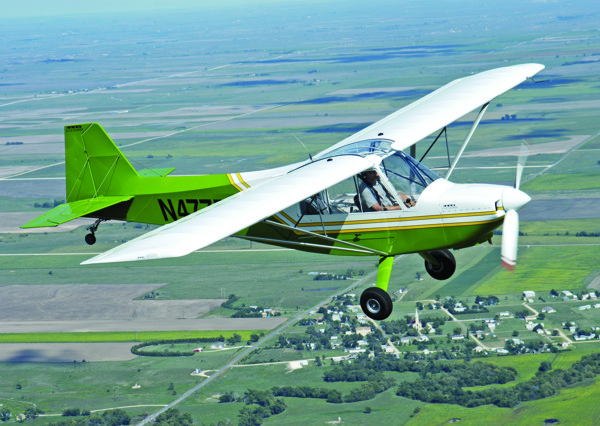








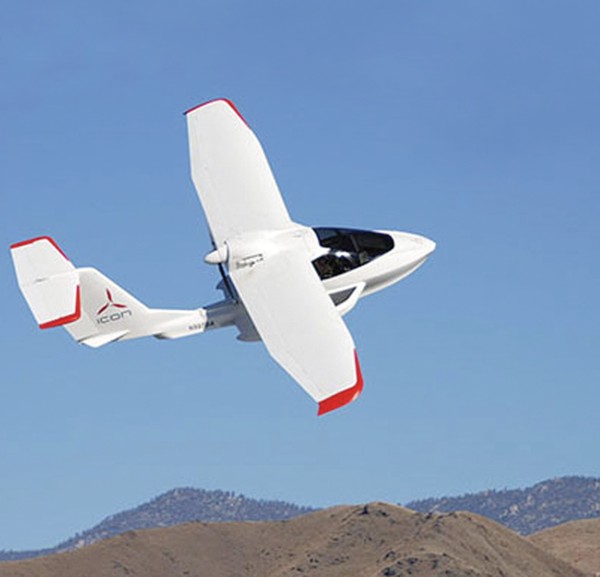














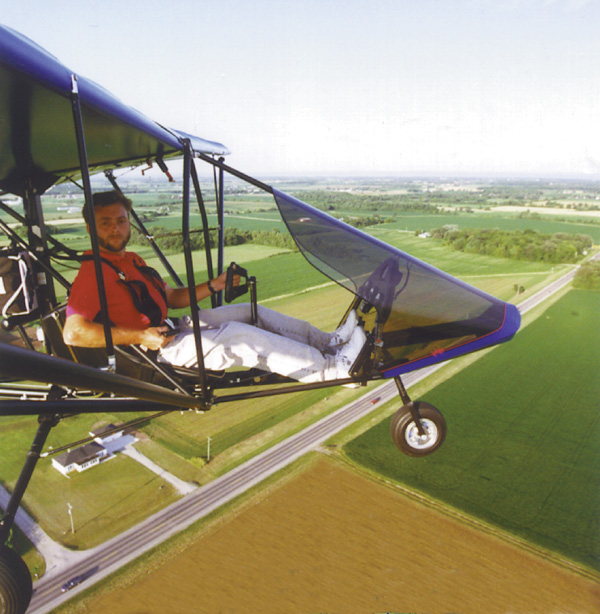


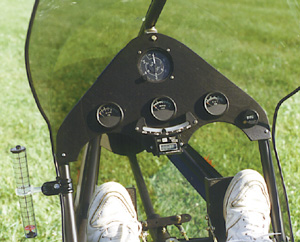
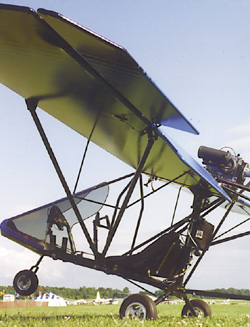


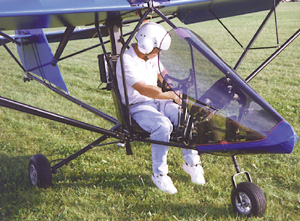





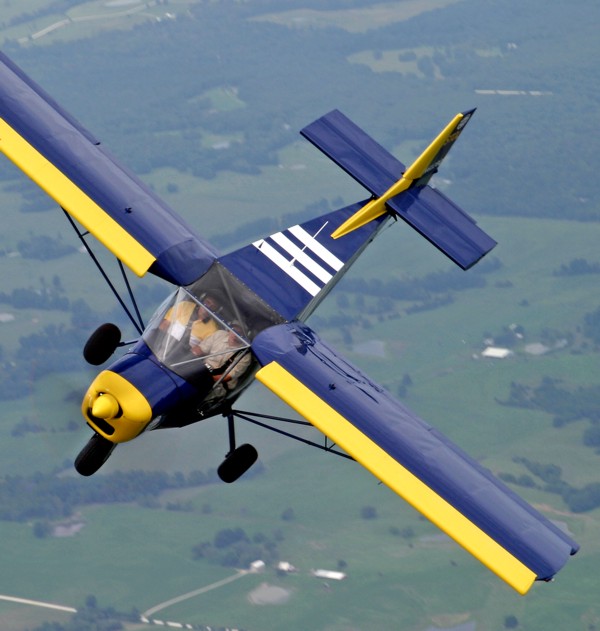


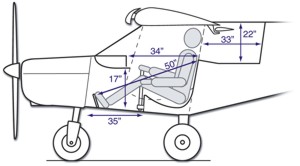
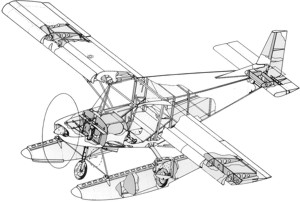


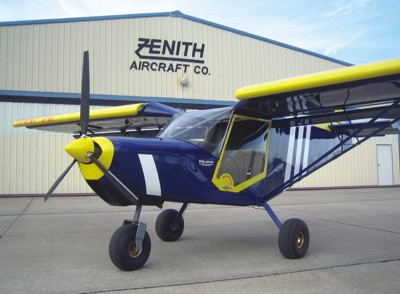





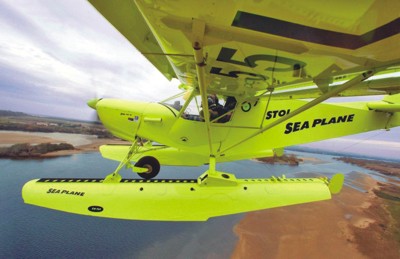
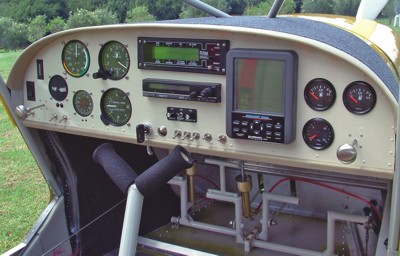

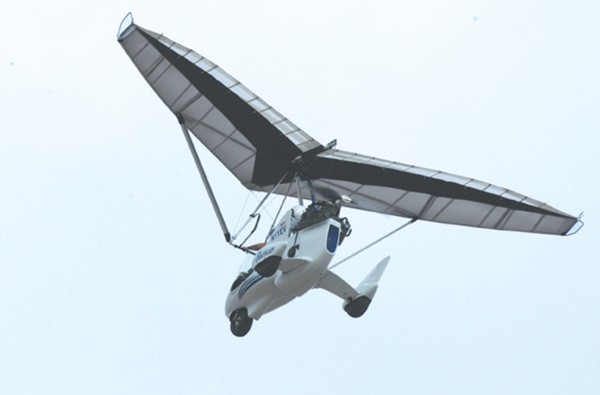 Behold the Revo, a new benchmark in weight-shift trike design.
Look carefully and you'll see the Revo is not like any weightshift
light-sport aircraft you've seen before. The Revo had to
surpass impressive work by larger, more established companies to leap
to the forefront. Any way you look at it, the Revo is simply extraordinary.
I've been lucky to fly many trikes over the years. Every few years, one
of the leading producers would make a remarkable step forward in the
design of these flying machines with changes that tended to be evolutionary,
not revolutionary. Among them, I cannot recall a clean sheet of
both carriage and wing debuted as a single aircraft.
Behold the Revo, a new benchmark in weight-shift trike design.
Look carefully and you'll see the Revo is not like any weightshift
light-sport aircraft you've seen before. The Revo had to
surpass impressive work by larger, more established companies to leap
to the forefront. Any way you look at it, the Revo is simply extraordinary.
I've been lucky to fly many trikes over the years. Every few years, one
of the leading producers would make a remarkable step forward in the
design of these flying machines with changes that tended to be evolutionary,
not revolutionary. Among them, I cannot recall a clean sheet of
both carriage and wing debuted as a single aircraft.
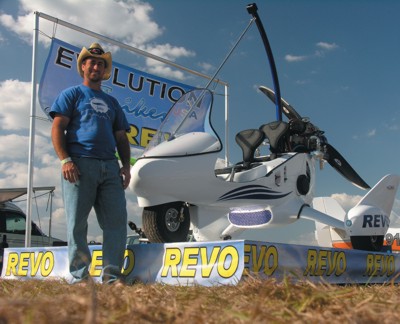 Welcome to Revo from Evolution Trikes, an all-new, blazingly fast
American trike like none before it.
The more I examined the Revo and then flew with Larry Mednick of
Evolution (and Tampabay Aerosports), I realized even Air Création's
beautiful Tanarg trike had been done one better. The Revo is a visual
treat thanks to its innovative design and stunning machine work. In the
air, the Revo is exhilarating to fly; a robust machine that manages to
handle lightly beyond your expectation.
REASONING REVO
Not only is Revo a superlative effort of design and fabrication, it sets a new trend
for trikes in several ways.
Welcome to Revo from Evolution Trikes, an all-new, blazingly fast
American trike like none before it.
The more I examined the Revo and then flew with Larry Mednick of
Evolution (and Tampabay Aerosports), I realized even Air Création's
beautiful Tanarg trike had been done one better. The Revo is a visual
treat thanks to its innovative design and stunning machine work. In the
air, the Revo is exhilarating to fly; a robust machine that manages to
handle lightly beyond your expectation.
REASONING REVO
Not only is Revo a superlative effort of design and fabrication, it sets a new trend
for trikes in several ways.
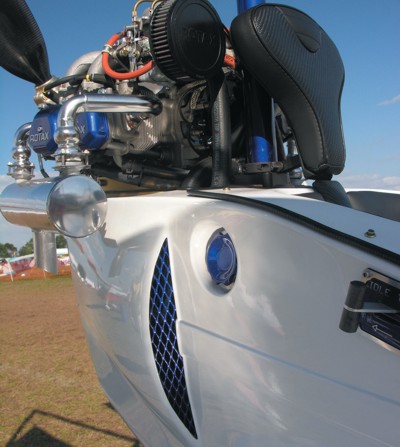 One, trikes were basically an American invention that found an audience overseas.
As the years passed, the lead in trike design went overseas, too.We had some
good American producers, but with stronger demand in Europe and elsewhere, the
baton of innovation mostly resided in countries like France, England, and Australia.
Two, with a history of the first trikes, we should have U.S. producers of note, and
Light Sport and Ultralight Flying Pilot's Report
we do, though they operate businesses less visible than
some of the legacy weight-shift brands such as Cosmos, Air
Création, Pegasus, and AirBorne. But lower visibility is
only temporary. After people get a gander at the Revo, they
could change their minds.
One, trikes were basically an American invention that found an audience overseas.
As the years passed, the lead in trike design went overseas, too.We had some
good American producers, but with stronger demand in Europe and elsewhere, the
baton of innovation mostly resided in countries like France, England, and Australia.
Two, with a history of the first trikes, we should have U.S. producers of note, and
Light Sport and Ultralight Flying Pilot's Report
we do, though they operate businesses less visible than
some of the legacy weight-shift brands such as Cosmos, Air
Création, Pegasus, and AirBorne. But lower visibility is
only temporary. After people get a gander at the Revo, they
could change their minds.
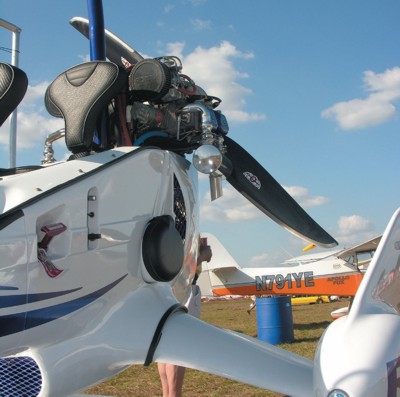 Three, the wings on the Revo come from another
American trike producer, but one that also produces wings
for their own trikes or a competitor's trike. North Wing is
a long established producer of wings for hang gliding and
for trike carrying. They also carry a lower profile without
lavish airshow displays. Yet I've known this company for
more than 30 years in the business. Under the leadership
of Kamron Blevins, North Wing has prospered.
Four, consider Florida company Evolution Trikes and
related enterprises. Tampabay Areosport is a trike training
school that got involved with several Hungarian-based
trikes over several years. They learned lessons from using
these trikes and they learned well. Finally Abid Farooqui
and Mednick decided to take their hard-won knowledge
and immense passion for trike flying to the limit. They
chose to design their own aircraft, from the wheel axles up
to the wingtips. For their story see the sidebar titled, "The
Evolution of Revolution."
REVO REVVED
Three, the wings on the Revo come from another
American trike producer, but one that also produces wings
for their own trikes or a competitor's trike. North Wing is
a long established producer of wings for hang gliding and
for trike carrying. They also carry a lower profile without
lavish airshow displays. Yet I've known this company for
more than 30 years in the business. Under the leadership
of Kamron Blevins, North Wing has prospered.
Four, consider Florida company Evolution Trikes and
related enterprises. Tampabay Areosport is a trike training
school that got involved with several Hungarian-based
trikes over several years. They learned lessons from using
these trikes and they learned well. Finally Abid Farooqui
and Mednick decided to take their hard-won knowledge
and immense passion for trike flying to the limit. They
chose to design their own aircraft, from the wheel axles up
to the wingtips. For their story see the sidebar titled, "The
Evolution of Revolution."
REVO REVVED
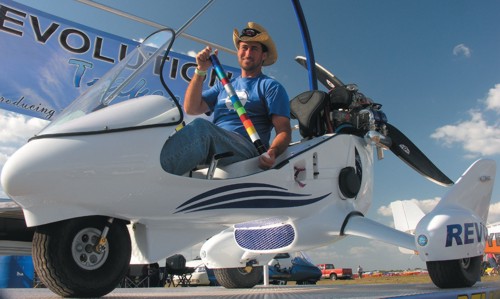 The public first saw the Revo at Sun 'n Fun '09, but it
didn't fly at the event. As you'll read elsewhere, the project
was declared complete in late '09 and it flew publicly at
Sebring 2010. If you watched as I did, you saw Larry
Mednick dashing around the pattern like he had someone
chasing him. This one trike was distinctive for its wickedfast
speed and an ability to fly in windy, gusty conditions
that even kept some 3-axis aircraft on the ground.
(Understand, Mednick's an expert trike pilot; I don't suggest
you should fly in strong conditions. Plus, let me add that Evolution Trikes offers
a 13-meter wing that is much more suitable to newer trike pilots, and a 15-meter single-
surface wing for those who want to explore slower speed trike flying.)
A year after its public debut, I flew with Mednick at Sun 'n Fun '10 in the Revo fitted
with a Reflex 11 wing. Not sure what to expect, I was pleasantly surprised.
The public first saw the Revo at Sun 'n Fun '09, but it
didn't fly at the event. As you'll read elsewhere, the project
was declared complete in late '09 and it flew publicly at
Sebring 2010. If you watched as I did, you saw Larry
Mednick dashing around the pattern like he had someone
chasing him. This one trike was distinctive for its wickedfast
speed and an ability to fly in windy, gusty conditions
that even kept some 3-axis aircraft on the ground.
(Understand, Mednick's an expert trike pilot; I don't suggest
you should fly in strong conditions. Plus, let me add that Evolution Trikes offers
a 13-meter wing that is much more suitable to newer trike pilots, and a 15-meter single-
surface wing for those who want to explore slower speed trike flying.)
A year after its public debut, I flew with Mednick at Sun 'n Fun '10 in the Revo fitted
with a Reflex 11 wing. Not sure what to expect, I was pleasantly surprised.
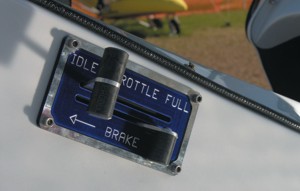 Sure, the takeoff roll was long on Paradise City's turf runway; we rolled approximately
700 feet, said Mednick. As trikes go, this Revo is heavy (530 pounds empty)
and it uses a small wing (118 square feet), so a longer run is to be expected. Mednick
pushed out early and when the Revo was ready, it smoothly departed the ground and
accelerated forward and upward. Climb appeared to be greater than 1,000 fpm as
best I could read the Enigma EFIS from the rear seat. Mednick had kindly offered
the front, but as I've learned, it's best to let a pilot experienced in the aircraft handle
the approach in and out of Sun 'n Fun's 1,400-foot strip in Paradise City.
Sure, the takeoff roll was long on Paradise City's turf runway; we rolled approximately
700 feet, said Mednick. As trikes go, this Revo is heavy (530 pounds empty)
and it uses a small wing (118 square feet), so a longer run is to be expected. Mednick
pushed out early and when the Revo was ready, it smoothly departed the ground and
accelerated forward and upward. Climb appeared to be greater than 1,000 fpm as
best I could read the Enigma EFIS from the rear seat. Mednick had kindly offered
the front, but as I've learned, it's best to let a pilot experienced in the aircraft handle
the approach in and out of Sun 'n Fun's 1,400-foot strip in Paradise City.
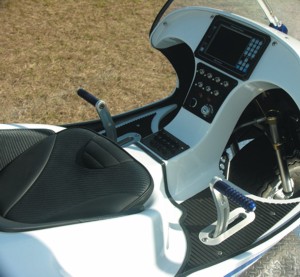 Shortly after launch, Mednick gave me the control bar. More specifically as I was
seated aft, I gripped the instructor bars attached to the triangular control frame.
Quickly I noted the ease of control. Since I'd estimated the Revo's wing loading, the
lightness didn't surprise me, but some big European trikes with small wings take
much more effort to turn than the Reflex 11 atop the Revo.
Steady-state turns were simple; no more power was needed. Stalls were uneventful;
even one with plenty of power (I couldn't tell precisely what percentage).
Shortly after launch, Mednick gave me the control bar. More specifically as I was
seated aft, I gripped the instructor bars attached to the triangular control frame.
Quickly I noted the ease of control. Since I'd estimated the Revo's wing loading, the
lightness didn't surprise me, but some big European trikes with small wings take
much more effort to turn than the Reflex 11 atop the Revo.
Steady-state turns were simple; no more power was needed. Stalls were uneventful;
even one with plenty of power (I couldn't tell precisely what percentage).
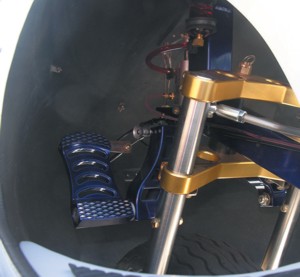 We went slowly (less than 50 mph) and we blazed past 100 mph indicated.
I expected to need the full-face
helmet Mednick offered, but truthfully, windblast
wasn't bad. Then Mednick asked me to place my
hand in front of him, specifically in the area he
occupied behind a sturdy windscreen. To my surprise,
the air movement was nil; you could probably
light a match. The windscreen design combined
with the faster speeds creates a wind shadow aft of
the screen, making a bubble of fairly calm air.
While I reached forward to sense the bubble, I
also noticed warmth. This open-cockpit aircraft has
"cabin" heat and it works. We didn't need it in
Florida, but I envision long flights at higher altitudes
where, I'm told, you could remain comfortable
without heavy clothing. Trike pilots in the
northern climates would greatly extend their flying
season thanks to the standard cabin heat and even
heated seats.
We went slowly (less than 50 mph) and we blazed past 100 mph indicated.
I expected to need the full-face
helmet Mednick offered, but truthfully, windblast
wasn't bad. Then Mednick asked me to place my
hand in front of him, specifically in the area he
occupied behind a sturdy windscreen. To my surprise,
the air movement was nil; you could probably
light a match. The windscreen design combined
with the faster speeds creates a wind shadow aft of
the screen, making a bubble of fairly calm air.
While I reached forward to sense the bubble, I
also noticed warmth. This open-cockpit aircraft has
"cabin" heat and it works. We didn't need it in
Florida, but I envision long flights at higher altitudes
where, I'm told, you could remain comfortable
without heavy clothing. Trike pilots in the
northern climates would greatly extend their flying
season thanks to the standard cabin heat and even
heated seats.
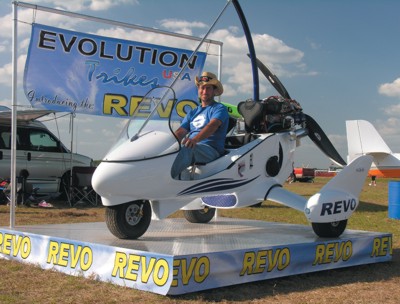 Mednick demonstrated the panel-mounted electric
trim. For years, trikes have offered on-theground
adjustments to move the wing fore or aft
slightly to change trim speed. And some, like
AirBorne Edge/Streak or the Air Création
Tanarg/iXess, have offered a trim wheel that
changes the shape of the center section trailing
edge. Both methods work, the latter much better
since you can change it in flight. But all predecessors
fall well short of the electrically adjusted trim
system on the Revo/Reflex. It appeared to change
the speed substantially, assuring a reduced pilot
fatigue factor especially on longer cruises at high
speed. Mednick further clarified, "Our optional inflight
electric trim gives the Revo more than a 45-
mph hands-off speed
range with an additional
20 mph
assuming a light
control force on the
bar beyond the max
trim settings."
Mednick demonstrated the panel-mounted electric
trim. For years, trikes have offered on-theground
adjustments to move the wing fore or aft
slightly to change trim speed. And some, like
AirBorne Edge/Streak or the Air Création
Tanarg/iXess, have offered a trim wheel that
changes the shape of the center section trailing
edge. Both methods work, the latter much better
since you can change it in flight. But all predecessors
fall well short of the electrically adjusted trim
system on the Revo/Reflex. It appeared to change
the speed substantially, assuring a reduced pilot
fatigue factor especially on longer cruises at high
speed. Mednick further clarified, "Our optional inflight
electric trim gives the Revo more than a 45-
mph hands-off speed
range with an additional
20 mph
assuming a light
control force on the
bar beyond the max
trim settings."
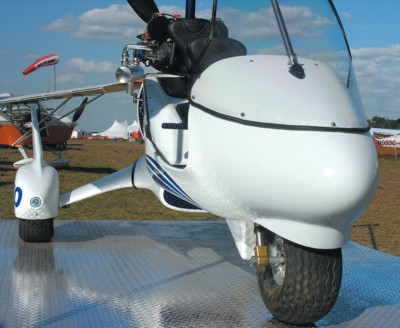 The Revo's responsive handling and reassuring
stability yielded a large speed window, from the
high 40s or low 50s to more than 100 mph. I saw
closer to 110 mph at one point and I can say this is
the fastest I've ever flown in a trike. Mednick said
the Revo's speed is "due to the high efficiency of the
clean aerodynamics and the low-twist wing."
While I didn't measure 45-to-45° roll reversals,
it's clear that the Reflex 11 has one of the fastest
roll rates among weight-shift LSA, which translates
to the pilot needing to make only small inputs
to achieve a desired bank angle. It also means you
can maintain control in rougher flying weather.
REVO MEANS REVOLUTION
The Revo has seen intensive development with
changes large and small. All are noteworthy so I
want to review a few details. Fortunately, since I
cannot cover everything, Mednick and his partner
Farooqui have put lots of information on their Website.
The Revo's responsive handling and reassuring
stability yielded a large speed window, from the
high 40s or low 50s to more than 100 mph. I saw
closer to 110 mph at one point and I can say this is
the fastest I've ever flown in a trike. Mednick said
the Revo's speed is "due to the high efficiency of the
clean aerodynamics and the low-twist wing."
While I didn't measure 45-to-45° roll reversals,
it's clear that the Reflex 11 has one of the fastest
roll rates among weight-shift LSA, which translates
to the pilot needing to make only small inputs
to achieve a desired bank angle. It also means you
can maintain control in rougher flying weather.
REVO MEANS REVOLUTION
The Revo has seen intensive development with
changes large and small. All are noteworthy so I
want to review a few details. Fortunately, since I
cannot cover everything, Mednick and his partner
Farooqui have put lots of information on their Website.
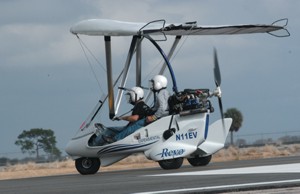 Reflex wings use struts instead of wire bracing.
Since the Reflex is small, the wing struts are short,
which makes them relatively stronger, which is
especially valuable under negative loads. For
redundancy, the wing struts have safety back-up
cables inside, as does the main support mast securing
the wing's keel to the keel of the trike carriage.
One of the seemingly mundane Revo features is a
kill switch, but it's not your typical kill switch.
Think about the problem. A trike uses a foot throttle
so the pilot can use both hands on the control
bar for takeoff or landing. All modern trikes add a
hand throttle to relieve the pilot during cruise.
Some, like the Revo, offer a second throttle setup for
an instructor. This is very convenient and allows for
safer teaching operation, but multiple throttles
have their downside. Evolution explains their concept
well. "The engine kill is part of the keyed ignition
on the Revo, and when the key ignition switch
is turned clockwise, the Revo starts, and when
turned counter-clockwise the engine shuts down,"
says the company.
Reflex wings use struts instead of wire bracing.
Since the Reflex is small, the wing struts are short,
which makes them relatively stronger, which is
especially valuable under negative loads. For
redundancy, the wing struts have safety back-up
cables inside, as does the main support mast securing
the wing's keel to the keel of the trike carriage.
One of the seemingly mundane Revo features is a
kill switch, but it's not your typical kill switch.
Think about the problem. A trike uses a foot throttle
so the pilot can use both hands on the control
bar for takeoff or landing. All modern trikes add a
hand throttle to relieve the pilot during cruise.
Some, like the Revo, offer a second throttle setup for
an instructor. This is very convenient and allows for
safer teaching operation, but multiple throttles
have their downside. Evolution explains their concept
well. "The engine kill is part of the keyed ignition
on the Revo, and when the key ignition switch
is turned clockwise, the Revo starts, and when
turned counter-clockwise the engine shuts down,"
says the company.
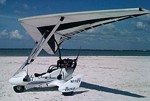 "Multiple serious accidents have derived from a
'run-away' trike that was started with one of the
throttle controls open. In some cases, these trikes
remained running long enough to allow the trike to
take off unintentionally. The reason these trikes
were not shut down more rapidly is that the magnetos
(used to kill the engine on many
aircraft) were in a different location
than the key switch or push-button to
start the trike. In some cases the
magnetos are located to the side of the
pilot and start button located on the
instrument panel, making the reaction
time too long in a real emergency.
It is a natural reaction to turn the key
the other way if the aircraft starts up
with wide-open throttle. With the
Revo, that intuitive reaction will stop
the engine instantly."
Speed is fun in many ways, and it
can also contribute to safety. Farooqui
explained, "Our carriage was designed to become
more stable in yaw the faster it travels, thanks to
our angled wheel spats."
When you need to slow down on the runway, you
use the hydraulic disc brakes installed on all three
wheels. In combination with the carriage's heavier
weight and a marvelous gear suspension, Sun 'n Fun's uneven
grass strip felt smoother than I've ever noticed.
Mednick told me, "While other trikes taxi around with their
suspension sprung out at the top of the travel range, the Revo
floats within a huge suspension range like a motocross bike." He
added that three-stage damping in the telescopic front forks
yield more than 3 inches of travel, added to another 3 inches of
travel via the large tires. The rear suspension has more than 8
inches of travel using the same leaf-spring method as a Cessna.
The Revo's electric trim uses a sliding hang block assembly
actuated by an electric linear actuator to provide dynamic inflight
trimming. Most trikes can do something similar, but only
on the ground with only a few limited adjustments, and it takes
time. "By electrically moving the hang point, the wing flies in
different trim speeds within the pitch stability of the wing and
the pilot feels nothing other than the wing's natural static pitch
force while in flight," reports Mednick.
For pilots of differing heights, the Revo offers quick-adjust
pedals with an infinite adjustment fore and aft and three positions
of angle. "Because so many short pilots cannot reach full
throttle and so many tall pilots cannot stay off the brakes, the
fully adjustable pedals will accommodate just about everyone,"
observes Mednick. In just seconds the pedals can be moved
without the use of tools.
By design, the control bar height appears lower than other
trikes. Farooqui said this keeps the pilot's hands below their
heart and keeps good circulation to the hands on long flights.
"You don't want your heart having to pump the blood up to
your hands," he says.
Comfort of occupants, including larger Americans, was considered
in the Revo's design. The rear seat is positioned further
aft to provide extra room. And the composite body assures the
aft-seat occupant has no seat frame pressing against his or her
thigh. A common trike irritation is the mast, which can buzz
against the rear-seat occupant's helmet in a most annoying
way. The Revo's curved mast allows the passenger to sit back
in the seat without touching his or her head to the mast (see
photos). As with most of the Revo, form follows function; things
work well but they also look good.
Optional arm rests for the aft seat give an additional sense
of security and a place for passenger's hands (better than them
grabbing the control bar at an inopportune time). To further
eliminate problems, the Revo's rear steering pedals can be
removed in seconds without the use of any tools, and stowed
easily in the glove box under the rear seat.
For aft- or front-seat occupants, you can stand on the floorboard
during entry; this is uncommon on trikes, which generally
use thin fairings that cannot withstand the weight of an
adult. Mednick indicated the floor is also great for inspecting
the inside of the wing and hang block area without needing to
stand on the seat or use a ladder during preflight.
The strut-braced Reflex wing can be folded while on the trike
without lowering the wing, though of course you must remove
all the ribs. A video on Evolution Trike's
Website shows Mednick doing the fold-up in
8 minutes.
REVO ENVY?
Calling any Revo configuration the
"basic" model suggests something less than
you want. That may not be the case here, as
the "basic" Revo is quite an aircraft for
$59,700 (which is subject to change as of
May '10). With the 80-hp Rotax 912UL 4-
stroke engine, you'll get everything you
need to fly day VFR including a monochrome
EFIS and a white gel coat composite
fairing with decals. It's sweet and many
could love the Revo just that way.
But this is aviation and pilots often want
something more. So Evolution Trikes has
options, lots of them. Here are just a few
too fat: a 100-hp Rotax 912S (+$2,500); engine top
cover ($500, to look cooler); painted trike body
($3,400, for what is called "nice carpaint
finish"); the taut Reflex 11 wing
($500, though the Reflex 13 is standard);
instructor package ($2,220 for various
control additions); color Enigma EFIS
($1,700); BRS parachute ($4,400);
Flycom helmet and intercom system
($1,800); comm radio ($1,500); Mode C
transponder ($3,150); electric trim system
($1,000, which I predict you'll want),
SLSA documentation package ($1,400,
allows for-hire rental or instruction).
All of the above except the instructor
bars and the Mode C transponder sums
to $78,400. If you want it all, the tab will
go over $80,000. That may seem like a
lot for a trike, but it's less than Air
Création asked for the Tanarg 3 years
ago and as good as the Tanarg was, Revo
is even more aircraft. For me, a $60,000
Revo sounds great, but even at $80,000 this is one
of the lower-priced SLSA you can buy.
When you get a chance to closely examine a Revo,
take a few minutes and really give it a look. I predict
the Revo will knock your socks off. Fly one at
your peril - you might just have to buy it.
"Multiple serious accidents have derived from a
'run-away' trike that was started with one of the
throttle controls open. In some cases, these trikes
remained running long enough to allow the trike to
take off unintentionally. The reason these trikes
were not shut down more rapidly is that the magnetos
(used to kill the engine on many
aircraft) were in a different location
than the key switch or push-button to
start the trike. In some cases the
magnetos are located to the side of the
pilot and start button located on the
instrument panel, making the reaction
time too long in a real emergency.
It is a natural reaction to turn the key
the other way if the aircraft starts up
with wide-open throttle. With the
Revo, that intuitive reaction will stop
the engine instantly."
Speed is fun in many ways, and it
can also contribute to safety. Farooqui
explained, "Our carriage was designed to become
more stable in yaw the faster it travels, thanks to
our angled wheel spats."
When you need to slow down on the runway, you
use the hydraulic disc brakes installed on all three
wheels. In combination with the carriage's heavier
weight and a marvelous gear suspension, Sun 'n Fun's uneven
grass strip felt smoother than I've ever noticed.
Mednick told me, "While other trikes taxi around with their
suspension sprung out at the top of the travel range, the Revo
floats within a huge suspension range like a motocross bike." He
added that three-stage damping in the telescopic front forks
yield more than 3 inches of travel, added to another 3 inches of
travel via the large tires. The rear suspension has more than 8
inches of travel using the same leaf-spring method as a Cessna.
The Revo's electric trim uses a sliding hang block assembly
actuated by an electric linear actuator to provide dynamic inflight
trimming. Most trikes can do something similar, but only
on the ground with only a few limited adjustments, and it takes
time. "By electrically moving the hang point, the wing flies in
different trim speeds within the pitch stability of the wing and
the pilot feels nothing other than the wing's natural static pitch
force while in flight," reports Mednick.
For pilots of differing heights, the Revo offers quick-adjust
pedals with an infinite adjustment fore and aft and three positions
of angle. "Because so many short pilots cannot reach full
throttle and so many tall pilots cannot stay off the brakes, the
fully adjustable pedals will accommodate just about everyone,"
observes Mednick. In just seconds the pedals can be moved
without the use of tools.
By design, the control bar height appears lower than other
trikes. Farooqui said this keeps the pilot's hands below their
heart and keeps good circulation to the hands on long flights.
"You don't want your heart having to pump the blood up to
your hands," he says.
Comfort of occupants, including larger Americans, was considered
in the Revo's design. The rear seat is positioned further
aft to provide extra room. And the composite body assures the
aft-seat occupant has no seat frame pressing against his or her
thigh. A common trike irritation is the mast, which can buzz
against the rear-seat occupant's helmet in a most annoying
way. The Revo's curved mast allows the passenger to sit back
in the seat without touching his or her head to the mast (see
photos). As with most of the Revo, form follows function; things
work well but they also look good.
Optional arm rests for the aft seat give an additional sense
of security and a place for passenger's hands (better than them
grabbing the control bar at an inopportune time). To further
eliminate problems, the Revo's rear steering pedals can be
removed in seconds without the use of any tools, and stowed
easily in the glove box under the rear seat.
For aft- or front-seat occupants, you can stand on the floorboard
during entry; this is uncommon on trikes, which generally
use thin fairings that cannot withstand the weight of an
adult. Mednick indicated the floor is also great for inspecting
the inside of the wing and hang block area without needing to
stand on the seat or use a ladder during preflight.
The strut-braced Reflex wing can be folded while on the trike
without lowering the wing, though of course you must remove
all the ribs. A video on Evolution Trike's
Website shows Mednick doing the fold-up in
8 minutes.
REVO ENVY?
Calling any Revo configuration the
"basic" model suggests something less than
you want. That may not be the case here, as
the "basic" Revo is quite an aircraft for
$59,700 (which is subject to change as of
May '10). With the 80-hp Rotax 912UL 4-
stroke engine, you'll get everything you
need to fly day VFR including a monochrome
EFIS and a white gel coat composite
fairing with decals. It's sweet and many
could love the Revo just that way.
But this is aviation and pilots often want
something more. So Evolution Trikes has
options, lots of them. Here are just a few
too fat: a 100-hp Rotax 912S (+$2,500); engine top
cover ($500, to look cooler); painted trike body
($3,400, for what is called "nice carpaint
finish"); the taut Reflex 11 wing
($500, though the Reflex 13 is standard);
instructor package ($2,220 for various
control additions); color Enigma EFIS
($1,700); BRS parachute ($4,400);
Flycom helmet and intercom system
($1,800); comm radio ($1,500); Mode C
transponder ($3,150); electric trim system
($1,000, which I predict you'll want),
SLSA documentation package ($1,400,
allows for-hire rental or instruction).
All of the above except the instructor
bars and the Mode C transponder sums
to $78,400. If you want it all, the tab will
go over $80,000. That may seem like a
lot for a trike, but it's less than Air
Création asked for the Tanarg 3 years
ago and as good as the Tanarg was, Revo
is even more aircraft. For me, a $60,000
Revo sounds great, but even at $80,000 this is one
of the lower-priced SLSA you can buy.
When you get a chance to closely examine a Revo,
take a few minutes and really give it a look. I predict
the Revo will knock your socks off. Fly one at
your peril - you might just have to buy it.

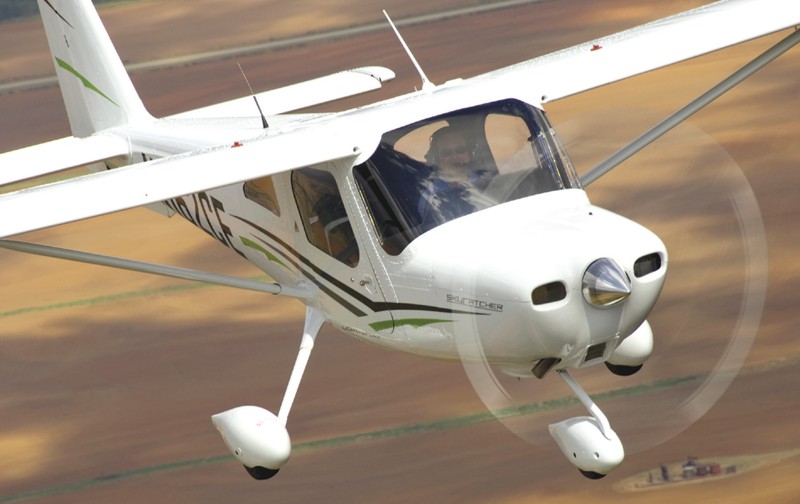
















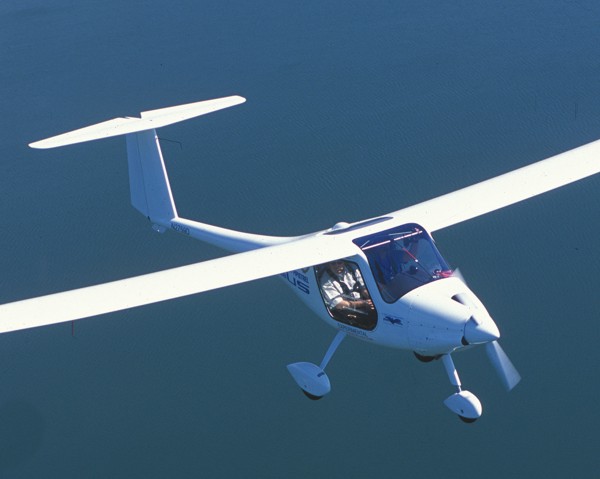


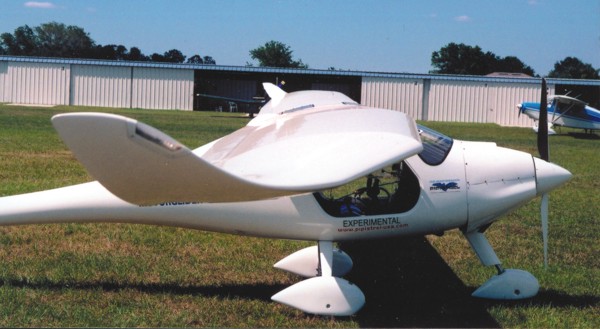








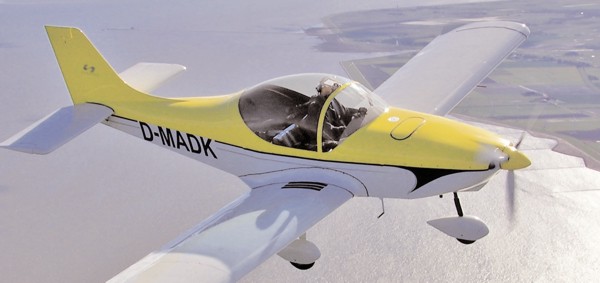
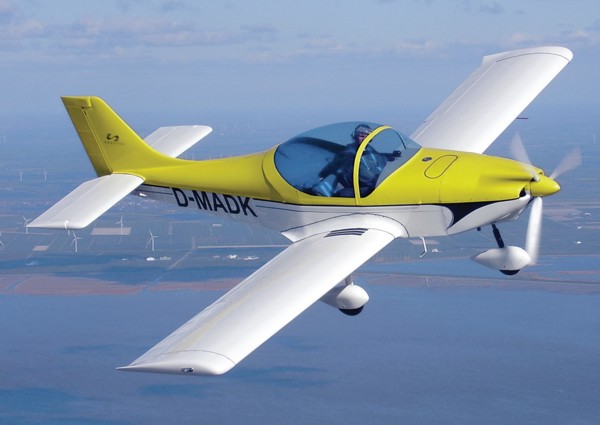

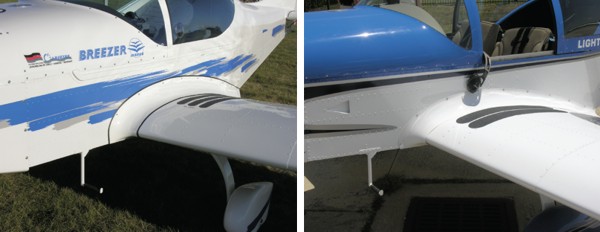





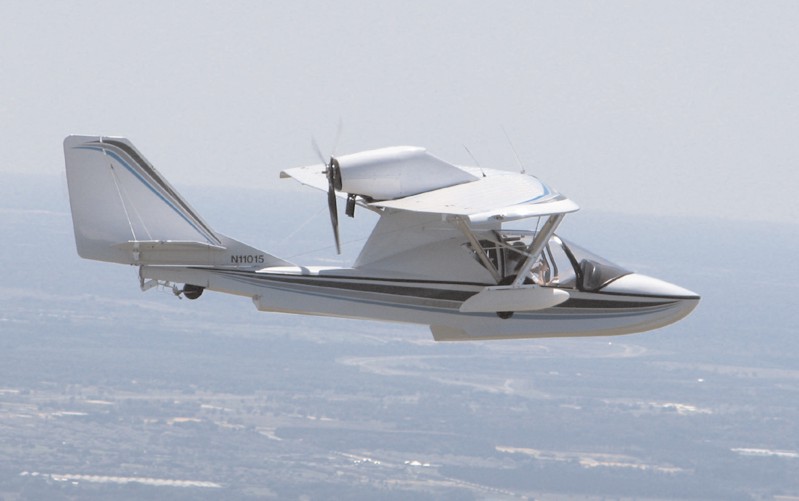
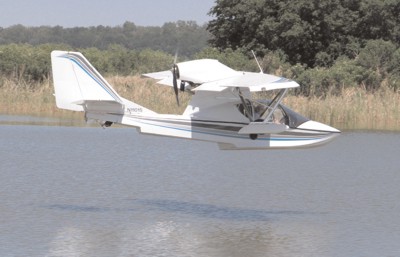















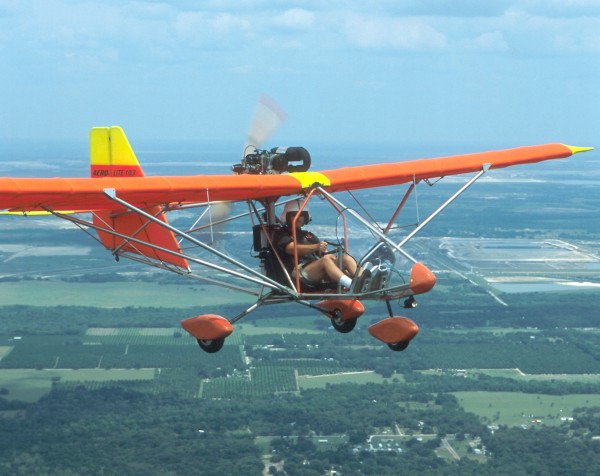



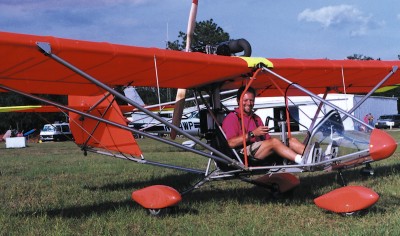


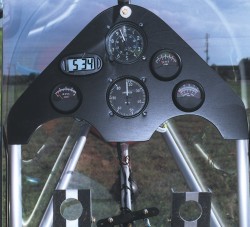
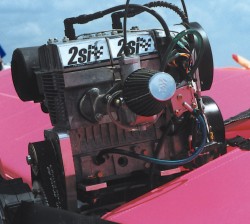

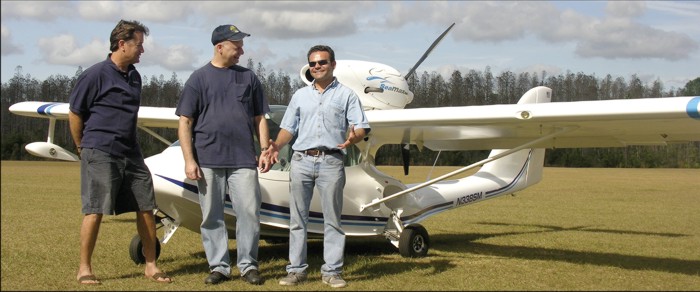
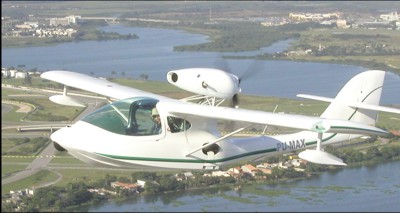
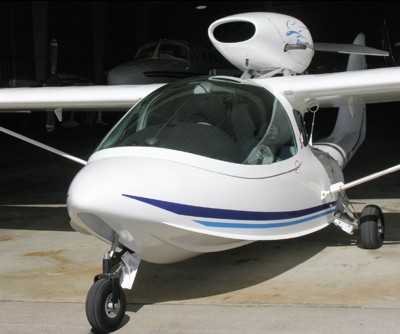















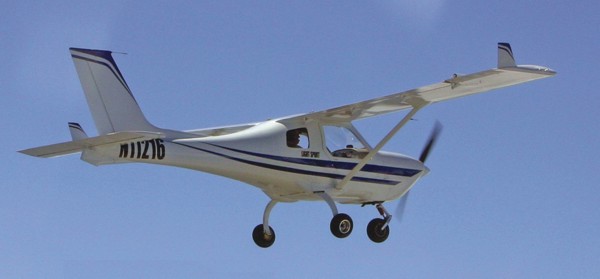
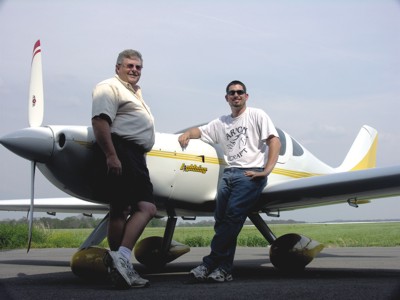
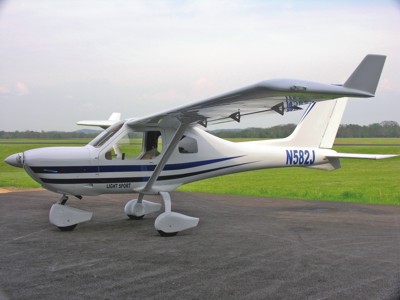
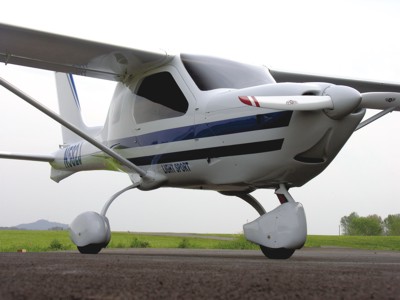
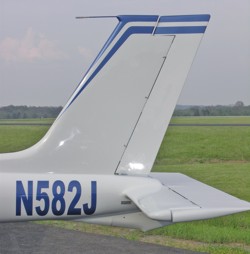
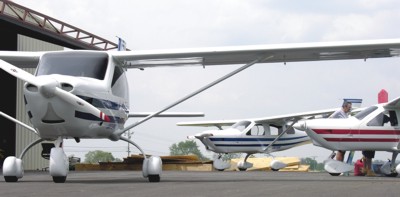
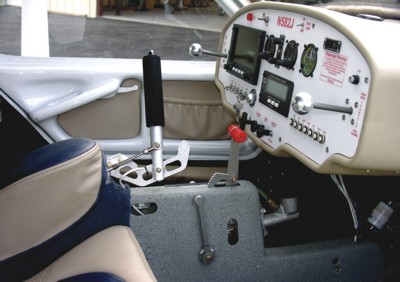
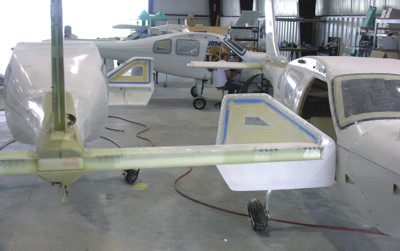


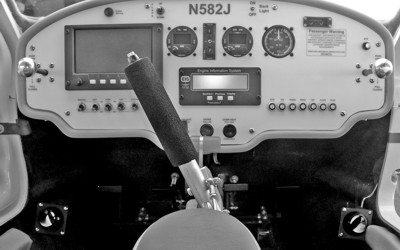
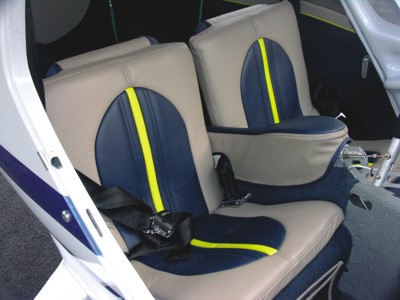

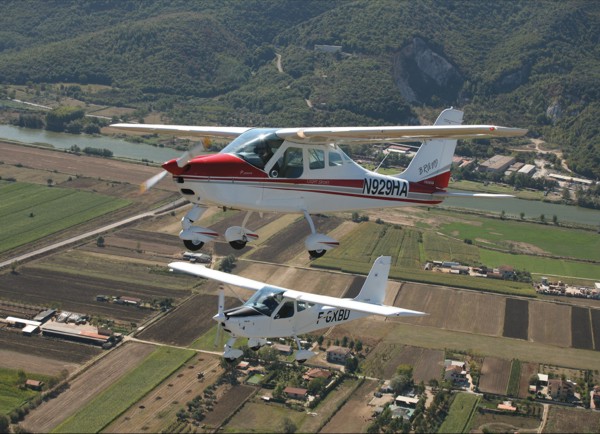




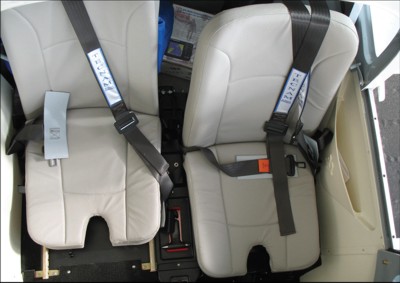

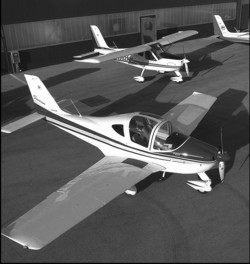



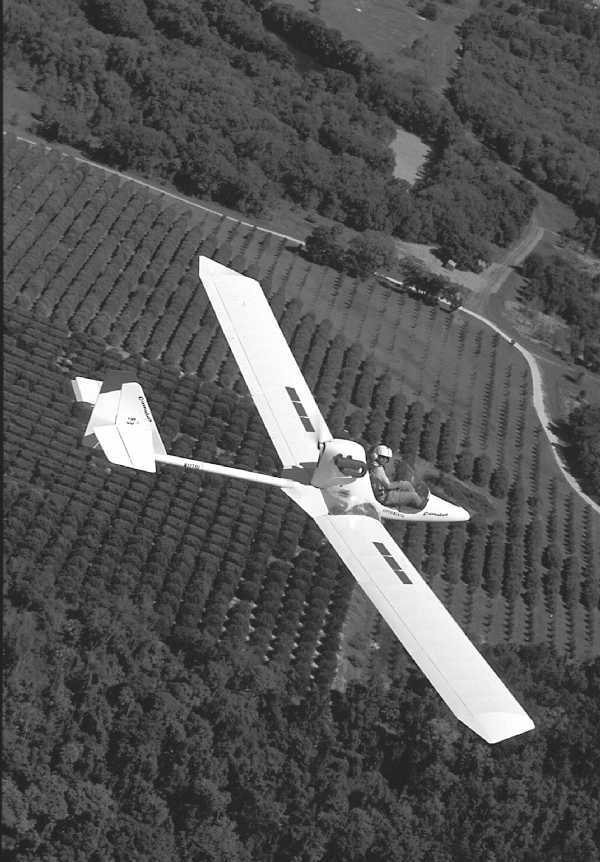













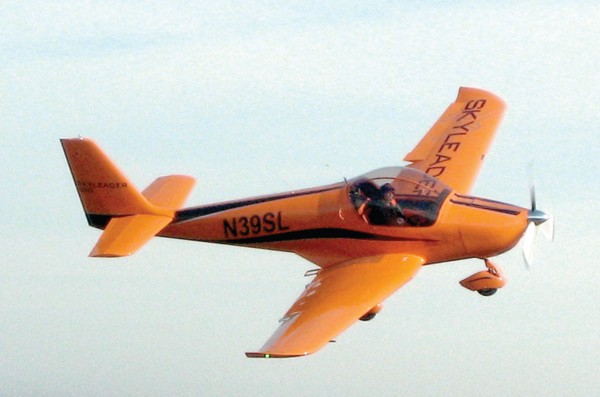 Unchanged are a common owner and the same skilled Jihlavan Airplanes
technicians building the elegant KP-5/Skyleader 500 from the Czech
Republic. It may not be the biggest seller among light sport aircraft (LSA),
but I find it to be one of the finest flying machines in the fleet. Skyleader
plans to standardize the brand around the world and will rename the KP-5
the Skyleader 500.
Unchanged are a common owner and the same skilled Jihlavan Airplanes
technicians building the elegant KP-5/Skyleader 500 from the Czech
Republic. It may not be the biggest seller among light sport aircraft (LSA),
but I find it to be one of the finest flying machines in the fleet. Skyleader
plans to standardize the brand around the world and will rename the KP-5
the Skyleader 500.
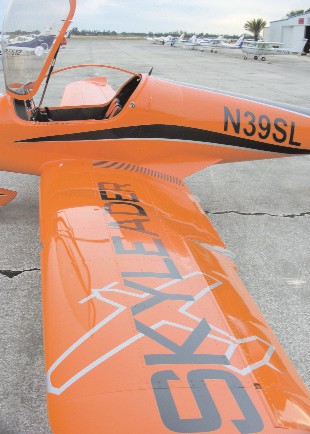 I've felt before and confirmed again that KP-5 (now Skyleader 500) is one of the sweetest handling Special Light-Sport Aircraft in the fleet.
Skyleader 500 is a handsomely styled, all-metal LSA with a high visibility
cockpit, a high-performance wing with well-regarded Fowler flaps, tough
trailing link landing gear and the 100-hp Rotax 912S powerplant. In '06, the
company altered the design for American consumption, widening the cockpit
to 47.2 inches, 8 inches wider than a Cessna 172 Skyhawk.
U.S.-based Kappa Aircraft is run by Edwin "Win" Miller, who comes from
an aviation-minded family that lived for a time in the Czech Republic. The
latter experience gives Win the ability to communicate with his Czechspeaking
supplier and to bridge the gap between Jihlavan/Skyleader and
American KP-5 enthusiasts.
I've felt before and confirmed again that KP-5 (now Skyleader 500) is one of the sweetest handling Special Light-Sport Aircraft in the fleet.
Skyleader 500 is a handsomely styled, all-metal LSA with a high visibility
cockpit, a high-performance wing with well-regarded Fowler flaps, tough
trailing link landing gear and the 100-hp Rotax 912S powerplant. In '06, the
company altered the design for American consumption, widening the cockpit
to 47.2 inches, 8 inches wider than a Cessna 172 Skyhawk.
U.S.-based Kappa Aircraft is run by Edwin "Win" Miller, who comes from
an aviation-minded family that lived for a time in the Czech Republic. The
latter experience gives Win the ability to communicate with his Czechspeaking
supplier and to bridge the gap between Jihlavan/Skyleader and
American KP-5 enthusiasts.
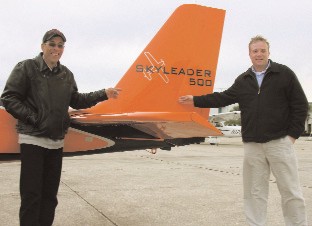 Antonin Pistek was the chief designer behind the
original KP-2U Sova, an airplane much like the KP-
5 Americans have seen but with retractable gear.
Presently a professor at the Czech Brno University
of Technology and head of the Department of
Aerospace Engineering, Pistek has a long background
in airplane development. In an interesting
twist, Pistek also led the design of Evektor's 5-seat
general aviation design called the Cobra.
Antonin Pistek was the chief designer behind the
original KP-2U Sova, an airplane much like the KP-
5 Americans have seen but with retractable gear.
Presently a professor at the Czech Brno University
of Technology and head of the Department of
Aerospace Engineering, Pistek has a long background
in airplane development. In an interesting
twist, Pistek also led the design of Evektor's 5-seat
general aviation design called the Cobra.
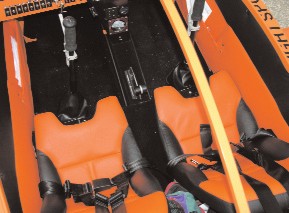 In early '06, Kappa 77 (the first company name)
was taken over by Jihlavan Airplanes. In fact, this
was a fairly minor change as Jihlavan had always
provided the facility and workers. Such cooperative
arrangements have long been common in Eastern
European countries. Win elaborates, "All the same
employees are making the Skyleader 500 as before,
providing continuity of the technical knowledge."
This same statement applies now that Skyleader
has become the new corporate marketing identity.
In early '06, Kappa 77 (the first company name)
was taken over by Jihlavan Airplanes. In fact, this
was a fairly minor change as Jihlavan had always
provided the facility and workers. Such cooperative
arrangements have long been common in Eastern
European countries. Win elaborates, "All the same
employees are making the Skyleader 500 as before,
providing continuity of the technical knowledge."
This same statement applies now that Skyleader
has become the new corporate marketing identity.
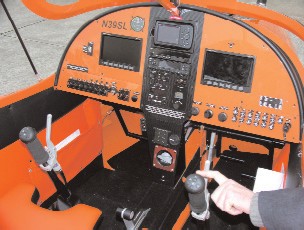 Kappa 77 had been collaborating with Jihlavan
since '96 so that by late '04, when Kappa 77 found
itself in financial trouble, the larger company was
encouraged to purchase all design rights and continue
with production.Win says experienced employees
are involved in the Jihlavan Airplanes division.
The larger Jihlavan enterprise is a 250-employee
component manufacturer specializing in aeronautical
hydraulics and actuators selling to Boeing, GE,
and SAAB. Since organizing in '52, Jihlavan has
built parts for MiGs and L-39s plus many others.
Jihlavan and Kappa 77 worked together to produce
the KP-5 model that Pennsylvania-based
Kappa Aircraft distributes to American buyers as a
Special-Light Sport Aircraft (SLSA).
Fowler Flaps
Kappa 77 had been collaborating with Jihlavan
since '96 so that by late '04, when Kappa 77 found
itself in financial trouble, the larger company was
encouraged to purchase all design rights and continue
with production.Win says experienced employees
are involved in the Jihlavan Airplanes division.
The larger Jihlavan enterprise is a 250-employee
component manufacturer specializing in aeronautical
hydraulics and actuators selling to Boeing, GE,
and SAAB. Since organizing in '52, Jihlavan has
built parts for MiGs and L-39s plus many others.
Jihlavan and Kappa 77 worked together to produce
the KP-5 model that Pennsylvania-based
Kappa Aircraft distributes to American buyers as a
Special-Light Sport Aircraft (SLSA).
Fowler Flaps
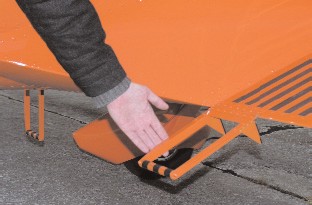 As Americans have looked over
the Kappa at several airshows
where the low-wing model has
been exhibited, one design feature
everyone seems to notice is the
superb Fowler flap execution. As
is common with this flap design,
Pistek and his engineering staff
extended Skyleader 500's Fowler
flaps well beyond the wing trailing
edge. Not only does this put
them in cleaner air, it adds considerable
square area to the wing,
which helps the design fly well at
slow speeds. The flaps also arc
downward with a wide gap to supply
optimal airflow over the surfaces.
As Americans have looked over
the Kappa at several airshows
where the low-wing model has
been exhibited, one design feature
everyone seems to notice is the
superb Fowler flap execution. As
is common with this flap design,
Pistek and his engineering staff
extended Skyleader 500's Fowler
flaps well beyond the wing trailing
edge. Not only does this put
them in cleaner air, it adds considerable
square area to the wing,
which helps the design fly well at
slow speeds. The flaps also arc
downward with a wide gap to supply
optimal airflow over the surfaces.
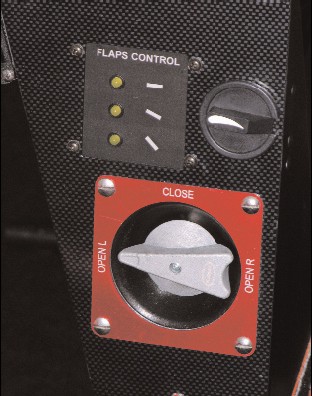 The Skyleader 500's flap linkage
is highly effective with 10°
and 35° of deployment guided by
a track arrangement. In flight you
can see and feel the effect of lowering
and moving aft the flaps to
the first position, and you then
sense a separate action when
those flaps descend noticeably to
the second position.
The Skyleader 500's flap linkage
is highly effective with 10°
and 35° of deployment guided by
a track arrangement. In flight you
can see and feel the effect of lowering
and moving aft the flaps to
the first position, and you then
sense a separate action when
those flaps descend noticeably to
the second position.
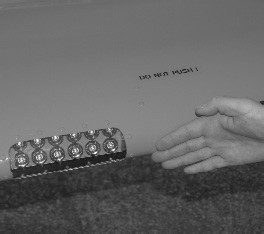 In my first flight experience in
the original KP-5, flaps were
mechanically deployed using a
button-detent Johnson Bar. I
found it took a significant physical
effort to get the second notch
deployed. My in-flight recorded
notes reflect that I had to yank
hard on the lever to engage maximum
flaps. Factory pilots used to
advise engaging the flaps at slower
speeds. Engineers even defended
the effort, saying the use of
mechanical actuation kept pilots
from lowering the flaps above recommended speed.
In my first flight experience in
the original KP-5, flaps were
mechanically deployed using a
button-detent Johnson Bar. I
found it took a significant physical
effort to get the second notch
deployed. My in-flight recorded
notes reflect that I had to yank
hard on the lever to engage maximum
flaps. Factory pilots used to
advise engaging the flaps at slower
speeds. Engineers even defended
the effort, saying the use of
mechanical actuation kept pilots
from lowering the flaps above recommended speed.
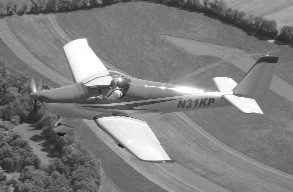 Despite the engineering argument, market forces
prevailed and today's wide-body Skyleader 500 has
electric flaps among several other changes. As
Skyleader has taken the reins, a new, easier-to-use
flap lever and position indicator are within easy
reach on the T-panel.
One of the most notable features of the KP-5 was
its staggered seat design that positions the left seat
6 inches in front of the right seat. Not everyone liked
this arrangement though I found it desirable for two
reasons: one, it afforded
more elbowroom to each
occupant and two, it
allowed either seat to have
a relatively unobstructed
view out both sides. The
ultralight Earthstar
Odyssey also successfully
employed this seating
arrangement. Skyleader
advises that the staggered
seat will remain as an
optional choice into the
future.
Just Introduced
However, as the '08 U.S.
Sport Aviation Expo concluded
in January, Kappa's
weather-delayed 2008
model revealed the newest
wide body variation. The
company showed side-byside
seating without the
stagger and they renamed the plane Skyleader 500
LSA.
After the company widened the cockpit to one of
the broadest in light aviation, people increasingly
inquired about the value of the staggered seats.Win
and the Czech engineers heard the market speaking.
So, one of Skyleader's first moves was switching to
conventional side-by-side seating. The wide-body
version of Skyleader 500 pushed the cabin beyond
47 inches, significantly broader than Cessna's
benchmark 172 Skyhawk 4-seater.
The Skyleader 500 LSA that finally made it to
Sebring, Florida, also showed a new step to aid
entry. Steps on each side hinge and can streamline
in flight. The revised model also showed a new interior
finish, a new flush-mounted leading edge landing
light employing LED lights ("very bright," says
Win), and other refinements such as cleaner looking
engine cowl fasteners and a more intuitive flap
switch.
"Flight schools like the Wide Body's extra width so
they can handle bigger students," reports Win. But
all occupants will enjoy the extra space. In keeping
with the thoughtful design of Skyleader 500, the
enlargement is well done without an obvious bulge
to identify how they created the extra space. Inside,
the center console was made narrower in the '06
upgrade yielding more foot room. In all, Americans
of any size should sense a comfortable cockpit.
The wide-body Skyleader 500 also has thicker
wing skins (now .027 aluminum and easily meeting
ASTM standards) fastened with filled pop rivets.
While such a change seems aimed at structural
upgrading, the plane seems to have a more solid feel
with no "oil-can" sounds audible to the occupants.
A button on the side of the hand brake helps set
the parking brake. Similarly, a starter button is mounted
on the left side of the throttle, though it is
now indented so it can't be inadvertently bumped.
"The final location may change in the future," indicates
Win. While this is an unusual location, the
starter is certainly easy to reach while maintaining
full control of the throttle. Other minor features are
also done differently, for example, the friction lock is
unique in my experience. But overall, the Skyleader
500 exhibits professionally achieved hardware.
Electric in-flight trim is optionally operated by
either left or right joystick switches, but not both, so
that both pilots cannot simultaneously move that
control. As is often the case when installed in this
location, the switch creates fairly fast response so
the better technique is to hit the button a series of
times and rarely hold it down. A small indicator
mounted to the left of the airspeed indicator on the
far left side of the panel provides a good visual display
of which way you're moving the trim.
Fortunately I was able to feel the effects of trim
quickly as the indicator was not a ready glance for a
pilot seated on the right. Since my flight, the trim
indicator has been moved to the center of the panel
for improved visibility by both pilot and co-pilot,
reports Kappa Aircraft.
Seats adjust via a lever under the seat, like car
seats. You can easily shift fore and aft while seated.
The seat cushion may feel short while you are
adjusting the seat, but since the cushion extends on
either side of the joystick it proved comfortable once
belted in position.
The Skyleader 500 rudder pedals are interesting
in that they hang low, contacting your foot about the
middle and affording a good control feel. As with
many things about the 500, this is a bit different but
a good difference.
The Skyleader factory is now offering higher quality
interiors including leather; interiors are similar
to Airtex brand in the U.S., says Win. The bright
orange example in the photos shows the new leather
seats with racing-seat-like bolsters.
Each joystick also has a push-to-talk switch allowing
you to keep your hand where it belongs during
takeoffs and landings. Across the
panel all-electric switches are
hooded or guarded to prevent their
inadvertent movement. Unusual in
a light sport plane, the Skyleader
500's twin fuel tanks are switchable.
You can burn one side more
than the other to aid lateral balance.
Wide-Body Visibility
KP-5 pilots have very good visibility
over the nose even from the
more-aft right seat. Naturally it's
optimal from the left seat.
Staggering the seating allows
each pilot to see laterally, but also
works well for an instructor to let a
left-seat student feel like he or she
is pilot-in-command. And it let
Jihlavan Airplanes' engineers keep
the cabin width narrower to
improve performance and fuel
usage. Seats in the new model are
the same size, but elbowroom is
reduced from the staggered version.
The canopy latch was redesigned and remounted
from the side to the overhead support with pins that
secure the sides of the canopy. It all happens with
one motion that either occupant can make.
Jihlavan provides a baggage area large enough to
hold 66 pounds, says the company. Baggage goes aft
of the seats and the adjustable-position seats lean
forward for access to the cargo area. Using a technique
like removing a drawer from a desk, you can
readily remove the seats to fill the cargo area to its
maximum allowed capacity.
You can also put some items in the standard hat
rack compartment, although Win noted that if an
emergency airframe parachute is chosen, the hat
rack is not available.
Toe brakes were installed only on the left seat
though Skyleader is working to offer toe brakes on
both sides as an option in the future. So far, most
American customers have ordered a hand brake
mounted to one or both joysticks. The hand brake is
also hydraulic. If customers choose this option, the
rudder pedals can then be adjusted for greater seating
versatility.
Flight Qualities
When Win and I flew around central Florida, I
wrote, "The KP-5 is one of the best handling aircraft
I've had the pleasure to fly." When I updated my
flight experience in the Wide Body KP-5 with Frank
Cuba, I was pleased to discover the earlier flight
qualities had not degraded when the fuselage was
widened. Among other low-wing LSA I've flown, the
KP-5/ Skyleader 500 remains one of my favorites.
Harmony in the controls is quite good. Pressures
are light and response is crisp without being sudden.
The Skyleader 500 can also make a good trainer
- its sturdy gear also serves this purpose - yet
experienced pilots will also appreciate its fine combination
of control ease and authority.
I figured rolls from 45° to 45° took about 3 seconds,
an estimate with which Cuba agreed. The
Wide Body Skyleader 500 offers very responsive
handling with modestly light control forces. Yet if
you bump the 500's joystick during a cross-country
flight - as you might while checking a map or making
a GPS adjustment, you won't upset the flight.
Steep turns went well in the Wide Body model. I
added a touch of power but then I ended up climbing
slightly in both left and right turns. The controls
weren't at fault; I tended to raise the nose too much
and we ended up climbing gently when I didn't
mind the altimeter. When the nose is in the proper
attitude it appears you are beginning a shallow
dive. The good visibility over the nose creates a
favorable impression once you adapt.
Cuba also flies an RV-8 but claims to prefer the
KP-5 to the popular Van's model. For cutting
through turbulence, the Kappa is strongly his
preference. He attributes this capability to what
he calls a "complex wing." He explains that as you
examine the wing, you see that at each bay the
line of rivets changes illustrating the wing's
sweep and taper.
Although the KP-5 slows down well as proved
by my experience with stalls, controls remain very
responsive right down to minimum flying speeds.
With those Fowler flaps extended well aft, the airplane
seems content flying at 45 mph.
The 100-hp Rotax 912S engine provides excellent
performance on this 1,278-pound gross
weight airplane. Climb rate was 800 to 900 fpm at
2,000 feet msl on an 80°, moderately humid day in
central Florida. At a slightly modest 4,900-rpm
power setting and at a low altitude, we were indicating
115 to 120 mph.
In a timed 1-minute descent rate check with
power to idle thrust and best glide speed of 70
Dynon mph, the KP-5 descended 550 feet.
Jihlavan developers claimed that with retractable
gear and an adjustable prop, the KP-5's glide
could be 18:1. With fixed gear and prop they feel
glide remains a very respectable 14:1. Whatever
the numbers, I could feel our test plane stretch a
glide and sink slowly.
Fuel sources are 8.5 gallons per wing tank filled
with your choice of low-lead avgas or high-test
auto gas. You can elect two more 4-gallon tanks
for a total of 25 gallons, which would equate to
more than 5 hours of range that could take you as
far as 650 miles.
The KP-5 gear is very forgiving and feels very
sturdy. I had three landings and Cuba said I tended
to raise the nose unnecessarily high, which
caused me to plop in on the gear. However, this
showed how wonderfully well the gear cushioned
my touchdowns. Cuba appeared not to have the
slightest concern as I made these highly scientific
evaluations.
Given the combination of low sink rate with
effective flaps and good low-speed handling, the
KP-5 accommodates takeoffs and landings with
ease. You may deploy those excellent flaps at 68
mph.
Comfortably Stable
I performed approach and departure stalls plus
accelerated stalls. Most fell to the right a little
faster than I'd consider optimal, but recovery was
always easy. In no case was power required to
recover from stall with minimal altitude loss.
After noting the right-hand break, I paid extra
attention when I did accelerated stalls to the
right. But even with the wing bank at about 45°,
the Kappa KP-5 rolled out level, confirming the
reasonable stall characteristics of this airplane.
My speculation is that this good quality may result from slipstream effect on the tail.
In accelerated stalls, a pronounced burbling identified
incipient stall. This was less evident in straight-ahead stalls,
but when the nose fell through it proved quite a benign
action.
All stalls came at very low speeds. Given instrument error
at the bottom of the range, I don't know if I can believe the
38-mph indication for stall. This represents only 38 mph,
making it 13.8 mph slower than the maximum for light sport
aircraft. Regardless of actual numbers, it's clear the KP-5
stalls very slowly, a great quality for instructional use. And,
in case you were wondering, all stalls were done without
using the superb Fowler flap system.
Checking longitudinal stability and disturbing the joystick
significantly forward produced a dive speed of about 120 mph
(per the Dynon set in mph). In just two oscillations, the KP-5
had returned to essentially level flight. Disturbing the stick
aft and releasing required three oscillations, but both showed
excellent stability with adverse pilot input.
Power stability showed that when power was reduced
swiftly from level trimmed flight, the KP-5 dove to 118 Dynon
miles an hour. When applying full power from level trimmed
flight, the KP-5 quickly leveled out.
Premium-Priced Kappa, er Skyleader
As '08 began, the base price of the Skyleader 500 Wide
Body remains $113,000, as it was in '07 and despite a significant
climb in the euro/dollar exchange rate. Thoroughly
equipped with dual Dynon displays, a Garmin 496 plus
radios, autopilot, and most other desirable equipment the
Skyleader has to offer, the KP-5/Skyleader 500 as tested was
priced at $138,000, making it an upper range SLSA.
Even at the base price you get quite a bit of value: 2 hours
of orientation flying, Garmin SL 40 radio and transponder,
VFR flight instruments and basic engine instruments, ELT
(required on an LSA but not always included in the base
price), hydraulic brakes, dual controls, cockpit lock, electric
trim, two (tail and belly) anti-collision lights, fuel gauges, fuel
pressure gauge, oil temp, tachometer, oil pressure, CHT, battery
recharging indicator, 12-volt socket, engine hourmeter,
VSI, altimeter, ASI, compass, and bank indicator.
Pilots considering a new LSA have many interesting choices
and price plays a major role or we wouldn't have some
models available in the $60,000 range (and yes, some are genuinely
available at that cost, fully built, ASTM-certified, and ready to fly home). Keeping it all in perspective,
most kit-built airplanes are hard to get in the air
with engine and basic avionics for less than $40,000
(though some ultralight kits remain aviation's
greatest bargains).
The Skyleader 500
may appear premium
priced and equipped; yet
after you've made payments
for a few years,
the total you paid may
no longer be as critical
as it seems when you
first contemplate financing
a $115,000 to
$130,000 airplane. With
AirFleet financing, you
could put down $26,000
(the price of some ultralight
kits with engine),
and make $877 monthly
payments. Does that
make the purchase tolerable?
If not, a growing
number of partner plans
can help you and a few
friends jointly own a KP-5. Or you could talk your
local flying club into
acquiring a Skyleader 500. Unless I miss my guess,
any airplane that flies as sweetly as a 500 would
find a substantial following in the USA. Go take a
demo and see if you don't agree.
Despite the engineering argument, market forces
prevailed and today's wide-body Skyleader 500 has
electric flaps among several other changes. As
Skyleader has taken the reins, a new, easier-to-use
flap lever and position indicator are within easy
reach on the T-panel.
One of the most notable features of the KP-5 was
its staggered seat design that positions the left seat
6 inches in front of the right seat. Not everyone liked
this arrangement though I found it desirable for two
reasons: one, it afforded
more elbowroom to each
occupant and two, it
allowed either seat to have
a relatively unobstructed
view out both sides. The
ultralight Earthstar
Odyssey also successfully
employed this seating
arrangement. Skyleader
advises that the staggered
seat will remain as an
optional choice into the
future.
Just Introduced
However, as the '08 U.S.
Sport Aviation Expo concluded
in January, Kappa's
weather-delayed 2008
model revealed the newest
wide body variation. The
company showed side-byside
seating without the
stagger and they renamed the plane Skyleader 500
LSA.
After the company widened the cockpit to one of
the broadest in light aviation, people increasingly
inquired about the value of the staggered seats.Win
and the Czech engineers heard the market speaking.
So, one of Skyleader's first moves was switching to
conventional side-by-side seating. The wide-body
version of Skyleader 500 pushed the cabin beyond
47 inches, significantly broader than Cessna's
benchmark 172 Skyhawk 4-seater.
The Skyleader 500 LSA that finally made it to
Sebring, Florida, also showed a new step to aid
entry. Steps on each side hinge and can streamline
in flight. The revised model also showed a new interior
finish, a new flush-mounted leading edge landing
light employing LED lights ("very bright," says
Win), and other refinements such as cleaner looking
engine cowl fasteners and a more intuitive flap
switch.
"Flight schools like the Wide Body's extra width so
they can handle bigger students," reports Win. But
all occupants will enjoy the extra space. In keeping
with the thoughtful design of Skyleader 500, the
enlargement is well done without an obvious bulge
to identify how they created the extra space. Inside,
the center console was made narrower in the '06
upgrade yielding more foot room. In all, Americans
of any size should sense a comfortable cockpit.
The wide-body Skyleader 500 also has thicker
wing skins (now .027 aluminum and easily meeting
ASTM standards) fastened with filled pop rivets.
While such a change seems aimed at structural
upgrading, the plane seems to have a more solid feel
with no "oil-can" sounds audible to the occupants.
A button on the side of the hand brake helps set
the parking brake. Similarly, a starter button is mounted
on the left side of the throttle, though it is
now indented so it can't be inadvertently bumped.
"The final location may change in the future," indicates
Win. While this is an unusual location, the
starter is certainly easy to reach while maintaining
full control of the throttle. Other minor features are
also done differently, for example, the friction lock is
unique in my experience. But overall, the Skyleader
500 exhibits professionally achieved hardware.
Electric in-flight trim is optionally operated by
either left or right joystick switches, but not both, so
that both pilots cannot simultaneously move that
control. As is often the case when installed in this
location, the switch creates fairly fast response so
the better technique is to hit the button a series of
times and rarely hold it down. A small indicator
mounted to the left of the airspeed indicator on the
far left side of the panel provides a good visual display
of which way you're moving the trim.
Fortunately I was able to feel the effects of trim
quickly as the indicator was not a ready glance for a
pilot seated on the right. Since my flight, the trim
indicator has been moved to the center of the panel
for improved visibility by both pilot and co-pilot,
reports Kappa Aircraft.
Seats adjust via a lever under the seat, like car
seats. You can easily shift fore and aft while seated.
The seat cushion may feel short while you are
adjusting the seat, but since the cushion extends on
either side of the joystick it proved comfortable once
belted in position.
The Skyleader 500 rudder pedals are interesting
in that they hang low, contacting your foot about the
middle and affording a good control feel. As with
many things about the 500, this is a bit different but
a good difference.
The Skyleader factory is now offering higher quality
interiors including leather; interiors are similar
to Airtex brand in the U.S., says Win. The bright
orange example in the photos shows the new leather
seats with racing-seat-like bolsters.
Each joystick also has a push-to-talk switch allowing
you to keep your hand where it belongs during
takeoffs and landings. Across the
panel all-electric switches are
hooded or guarded to prevent their
inadvertent movement. Unusual in
a light sport plane, the Skyleader
500's twin fuel tanks are switchable.
You can burn one side more
than the other to aid lateral balance.
Wide-Body Visibility
KP-5 pilots have very good visibility
over the nose even from the
more-aft right seat. Naturally it's
optimal from the left seat.
Staggering the seating allows
each pilot to see laterally, but also
works well for an instructor to let a
left-seat student feel like he or she
is pilot-in-command. And it let
Jihlavan Airplanes' engineers keep
the cabin width narrower to
improve performance and fuel
usage. Seats in the new model are
the same size, but elbowroom is
reduced from the staggered version.
The canopy latch was redesigned and remounted
from the side to the overhead support with pins that
secure the sides of the canopy. It all happens with
one motion that either occupant can make.
Jihlavan provides a baggage area large enough to
hold 66 pounds, says the company. Baggage goes aft
of the seats and the adjustable-position seats lean
forward for access to the cargo area. Using a technique
like removing a drawer from a desk, you can
readily remove the seats to fill the cargo area to its
maximum allowed capacity.
You can also put some items in the standard hat
rack compartment, although Win noted that if an
emergency airframe parachute is chosen, the hat
rack is not available.
Toe brakes were installed only on the left seat
though Skyleader is working to offer toe brakes on
both sides as an option in the future. So far, most
American customers have ordered a hand brake
mounted to one or both joysticks. The hand brake is
also hydraulic. If customers choose this option, the
rudder pedals can then be adjusted for greater seating
versatility.
Flight Qualities
When Win and I flew around central Florida, I
wrote, "The KP-5 is one of the best handling aircraft
I've had the pleasure to fly." When I updated my
flight experience in the Wide Body KP-5 with Frank
Cuba, I was pleased to discover the earlier flight
qualities had not degraded when the fuselage was
widened. Among other low-wing LSA I've flown, the
KP-5/ Skyleader 500 remains one of my favorites.
Harmony in the controls is quite good. Pressures
are light and response is crisp without being sudden.
The Skyleader 500 can also make a good trainer
- its sturdy gear also serves this purpose - yet
experienced pilots will also appreciate its fine combination
of control ease and authority.
I figured rolls from 45° to 45° took about 3 seconds,
an estimate with which Cuba agreed. The
Wide Body Skyleader 500 offers very responsive
handling with modestly light control forces. Yet if
you bump the 500's joystick during a cross-country
flight - as you might while checking a map or making
a GPS adjustment, you won't upset the flight.
Steep turns went well in the Wide Body model. I
added a touch of power but then I ended up climbing
slightly in both left and right turns. The controls
weren't at fault; I tended to raise the nose too much
and we ended up climbing gently when I didn't
mind the altimeter. When the nose is in the proper
attitude it appears you are beginning a shallow
dive. The good visibility over the nose creates a
favorable impression once you adapt.
Cuba also flies an RV-8 but claims to prefer the
KP-5 to the popular Van's model. For cutting
through turbulence, the Kappa is strongly his
preference. He attributes this capability to what
he calls a "complex wing." He explains that as you
examine the wing, you see that at each bay the
line of rivets changes illustrating the wing's
sweep and taper.
Although the KP-5 slows down well as proved
by my experience with stalls, controls remain very
responsive right down to minimum flying speeds.
With those Fowler flaps extended well aft, the airplane
seems content flying at 45 mph.
The 100-hp Rotax 912S engine provides excellent
performance on this 1,278-pound gross
weight airplane. Climb rate was 800 to 900 fpm at
2,000 feet msl on an 80°, moderately humid day in
central Florida. At a slightly modest 4,900-rpm
power setting and at a low altitude, we were indicating
115 to 120 mph.
In a timed 1-minute descent rate check with
power to idle thrust and best glide speed of 70
Dynon mph, the KP-5 descended 550 feet.
Jihlavan developers claimed that with retractable
gear and an adjustable prop, the KP-5's glide
could be 18:1. With fixed gear and prop they feel
glide remains a very respectable 14:1. Whatever
the numbers, I could feel our test plane stretch a
glide and sink slowly.
Fuel sources are 8.5 gallons per wing tank filled
with your choice of low-lead avgas or high-test
auto gas. You can elect two more 4-gallon tanks
for a total of 25 gallons, which would equate to
more than 5 hours of range that could take you as
far as 650 miles.
The KP-5 gear is very forgiving and feels very
sturdy. I had three landings and Cuba said I tended
to raise the nose unnecessarily high, which
caused me to plop in on the gear. However, this
showed how wonderfully well the gear cushioned
my touchdowns. Cuba appeared not to have the
slightest concern as I made these highly scientific
evaluations.
Given the combination of low sink rate with
effective flaps and good low-speed handling, the
KP-5 accommodates takeoffs and landings with
ease. You may deploy those excellent flaps at 68
mph.
Comfortably Stable
I performed approach and departure stalls plus
accelerated stalls. Most fell to the right a little
faster than I'd consider optimal, but recovery was
always easy. In no case was power required to
recover from stall with minimal altitude loss.
After noting the right-hand break, I paid extra
attention when I did accelerated stalls to the
right. But even with the wing bank at about 45°,
the Kappa KP-5 rolled out level, confirming the
reasonable stall characteristics of this airplane.
My speculation is that this good quality may result from slipstream effect on the tail.
In accelerated stalls, a pronounced burbling identified
incipient stall. This was less evident in straight-ahead stalls,
but when the nose fell through it proved quite a benign
action.
All stalls came at very low speeds. Given instrument error
at the bottom of the range, I don't know if I can believe the
38-mph indication for stall. This represents only 38 mph,
making it 13.8 mph slower than the maximum for light sport
aircraft. Regardless of actual numbers, it's clear the KP-5
stalls very slowly, a great quality for instructional use. And,
in case you were wondering, all stalls were done without
using the superb Fowler flap system.
Checking longitudinal stability and disturbing the joystick
significantly forward produced a dive speed of about 120 mph
(per the Dynon set in mph). In just two oscillations, the KP-5
had returned to essentially level flight. Disturbing the stick
aft and releasing required three oscillations, but both showed
excellent stability with adverse pilot input.
Power stability showed that when power was reduced
swiftly from level trimmed flight, the KP-5 dove to 118 Dynon
miles an hour. When applying full power from level trimmed
flight, the KP-5 quickly leveled out.
Premium-Priced Kappa, er Skyleader
As '08 began, the base price of the Skyleader 500 Wide
Body remains $113,000, as it was in '07 and despite a significant
climb in the euro/dollar exchange rate. Thoroughly
equipped with dual Dynon displays, a Garmin 496 plus
radios, autopilot, and most other desirable equipment the
Skyleader has to offer, the KP-5/Skyleader 500 as tested was
priced at $138,000, making it an upper range SLSA.
Even at the base price you get quite a bit of value: 2 hours
of orientation flying, Garmin SL 40 radio and transponder,
VFR flight instruments and basic engine instruments, ELT
(required on an LSA but not always included in the base
price), hydraulic brakes, dual controls, cockpit lock, electric
trim, two (tail and belly) anti-collision lights, fuel gauges, fuel
pressure gauge, oil temp, tachometer, oil pressure, CHT, battery
recharging indicator, 12-volt socket, engine hourmeter,
VSI, altimeter, ASI, compass, and bank indicator.
Pilots considering a new LSA have many interesting choices
and price plays a major role or we wouldn't have some
models available in the $60,000 range (and yes, some are genuinely
available at that cost, fully built, ASTM-certified, and ready to fly home). Keeping it all in perspective,
most kit-built airplanes are hard to get in the air
with engine and basic avionics for less than $40,000
(though some ultralight kits remain aviation's
greatest bargains).
The Skyleader 500
may appear premium
priced and equipped; yet
after you've made payments
for a few years,
the total you paid may
no longer be as critical
as it seems when you
first contemplate financing
a $115,000 to
$130,000 airplane. With
AirFleet financing, you
could put down $26,000
(the price of some ultralight
kits with engine),
and make $877 monthly
payments. Does that
make the purchase tolerable?
If not, a growing
number of partner plans
can help you and a few
friends jointly own a KP-5. Or you could talk your
local flying club into
acquiring a Skyleader 500. Unless I miss my guess,
any airplane that flies as sweetly as a 500 would
find a substantial following in the USA. Go take a
demo and see if you don't agree.

